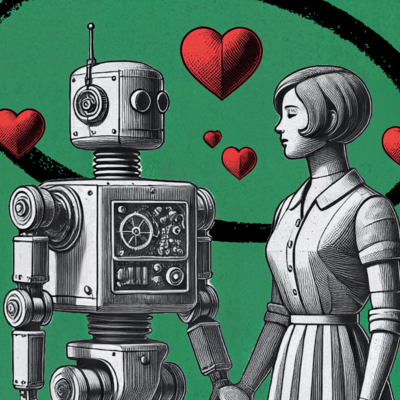
Sponsored By: AE Studio
This essay is brought to you by AE Studio, your go-to partner for custom-built AI-powered software. Transform your idea into reality faster than ever before, with bespoke MVPs designed especially for you.
TL;DR
- The internet is still underrated and only has <70% global usage
- The internet is mature enough, however, that we can begin to see its long-term impact
- The most important thing to know is that the internet is far weirder and more bizarre than we could’ve predicted
- Companies can take on much more ambitious missions while collapsing jobs, hiring one person where they would have hired two, and departments merging in ways totally impossible ten years ago
- Industries that many expected to wither at the advent of the internet, like books and bookstores, are thriving
- AI is the culmination of thirty years of the commercial internet
- All of this change is terrifying and exciting. Founders and operators have the latitude to wildly experiment and reinvent in ways that were never before possible.
The internet is a seething mass of humanity: all of our knowledge and stupidity and joy and hatred shoved into pixels. Our early oracles predicted that the internet would become a digital savior—it would spread democracy and science throughout the world. That, well, that was wrong. What it did instead was spread us, in our excess and folly, everywhere, instantly.
It is tempting to dismiss the internet as yesterday’s revolution. Surely, after 30 years of pop-ups and porn, we would’ve figured it out. The opposite is true. We haven’t even gotten everyone online yet.
In 2022, only 64.4% of the world had internet access. Of the planet's roughly 8B total residents, only 5.16B are online. In the U.S., the country where the internet browser was invented, we have plateaued at 93% internet usage. In countries earlier in the technology journey, the difference is stark: Kenya is sitting at 32%.
Imagine merging the ingenuity of developers, data scientists, and designers into one team, dedicated to your business success. That's us, your accelerators at AE Studio, crafting custom AI and software solutions tailored specifically for you.
We don't just build tech, we work hand-in-glove with you, bringing ideas into reality faster than your rivals. From MVPs that test your concept to AI that fosters innovation, we're here to maximize your ROI.
Join the legion of founders and executives who've experienced AE's Rapid Success Model. Let's transform your business together. Free scoping session? It's on us.
Millions of miles of fiber optic cables, 4,500 Starlink satellites careening through the sky, a mountain of hardware, and all the infrastructure we’ve been building since 1993, are just support beams for this mysterious thing.
We are now at a point of sufficient internet development to understand what the real implications of it will be. It won't be utopia. It won’t be hell. Instead, it’ll be society evolved.
We thought we could neatly package up the best of humanity and then copy/paste it into the online format. However, by digitizing all information, we changed the materiality of anything the internet touched. When you throw something online, whether it is as simple as a blog post or as complex as an entire organization, you alter what it can do and be.
These are all very abstract, hand-wavy ideas. What I’m guessing you are interested in is pragmatic application.
How has the internet changed us? In the 90s the answer to this question was, as I mentioned, the responsibility of philosophers. Now, we have enough examples and data to make this question the work of practitioners.
To understand why these changes are occurring, we need to grok the fundamental force at the heart of the internet: reduced distribution costs.
Digital Rails
The internet is a digital railroad network that transports information. And if we have been building “digital rails,” then maybe the impact of our physical rail network has something to teach us.
The total track miles for the US system topped off in 1916 after 100 years of blasting through the Rockies and clear cutting through northern timber. But even as the network collapsed, the revenue per mile skyrocketed. In 1916, the inflation adjusted revenue per mile was $307K compared to the $823K of 2014. A cool way to make money, but only relevant if you happen to be a choo choo enthusiast.
The more meaningful change was what happened to society. An extensive rail network dramatically reduced distribution costs. That is a bit of a trite sentence but reduced costs really matter.
Reduced distribution cost makes new industries possible. One of the fastest ways to improve society is to make yesterday’s luxury into today’s commodity. The only way that happens is by decreasing cost. The railroad network did just that for essentially every physical good in America.
To help visualize the impact this expanded railroad network had, let’s examine the ice trade. This industry would cut out blocks of ice from ponds and lakes in the North and then ship that ice throughout the U.S. Before rails, it mostly relied on barges and wagons.
Ice workers hauling their product. (I apologize for the image quality but also, this photo is like 120 years old so get over yourself if this quality makes you grumpy).
As the rail system became more extensive in the 19th century, the ice trade shifted focus to supplying the booming cities on the east coast and businesses in the heartland. New Yorkers and Philadelphians, sweltering in the summer heat, became voracious consumers of ice hacked from the Hudson and shipped down from Maine. Railroad companies deployed refrigerator cars chilled by blocks of ice, enabling Chicago’s meatpackers to slaughter locally before sending steak across the nation. Refrigeration transformed the produce industry, liberating grocery stores from the tyranny of regional seasonality. With ice-preserved catches, fishermen could venture farther and land bigger hauls. The year-round availability of chilled beer and ale quenched a nation's thirst. Beer and meat and cheese and vegetables, all available, all year, all because the railroad made it cheap and easy to distribute physical goods.
The internet does the same thing for information. By making the distribution of information free and infinite, it changes what is possible. In contrast with previous technology paradigms (steam, electricity) the primary cost being reduced is cognitive, not physical.
For organizations that means a decrease in coordination costs and increase in capabilities.
The Amazon story
When the internet first started there was a rush of retailers going online. Jeff Bezos was one of them. As he incubated the idea that became Amazon, he looked at the book sellers and had a realization: all of the current e-commerce sites were static pages.
In practice this meant that when you went to a bookstore’s website, you would be looking at a picture of their shelves frozen in time. You just had to hope that the picture was up to date. Bezos intuited that he could use code to create a dynamic page that updated with the inventory in real time. This little idea of updating your inventory in real-time was the seed that enabled him to build the “everything store.” Connecting book inventories to the internet allowed e-commerce to flourish.
The internet enabled a new, online-only business model. The free distribution of data applied meant dynamic web pages. The decreased coordination costs allowed for real time inventory updates. Finally, this increase in capabilities gave Amazon the ability to stock every book on the planet.
Of course, this is interesting but predictable. There were many entrepreneurs who guessed this was going to happen with the internet—Bezos was just the one who got it right. What’s even more fascinating is the second and third order effects that have happened over the last ten years.
First, consumers made it clear that they didn’t care about shopping online only or in-person. They would rather the goods they wanted were present everywhere.
Omnichannel, being simultaneously present online and in physical form, came to rule the roost. This is why in every overpriced shopping center hub in America you can find some combination of Warby Parker and All Birds stores. Shopping transformed into an activity that was simultaneously digital and physical.
Second, because the internet allowed for targeted, real-time updates to inventories, Amazon realized they could monetize this capability with advertisements. Retailers could pay for more prominent placement on their digital shelves.
The division was quietly built until 2022 when the company disclosed that the division had done $32B in revenue. The ad business is now so large that it has now surpassed the revenue from Amazon Prime. These ads are not a new idea—physical retailers have long charged fees to companies looking for prime shelf placement. The new features were the infinite shelf space, personal customization, and dynamic inventory that the internet allowed.
For these revolutions, both omnichannel and digital ads, ask yourself: what division of the company is this? Is a new retail store a marketing expense? After all, retailers have repeatedly told investors that a physical location increases ad sales. Or is it a capital expenditure? Under U.S. accounting law a newly purchased store would probably go under that line item.
To make this even more complicated, Amazon does all sorts of things beyond retail work. They own grocery stores, movie studios, pharmacies, healthcare clinics, and they are shooting satellites into space (ironically for today, those satellites are meant to increase internet access).
The collapse of organizations
Theoretically, all of these initiatives are connected by the internet. Amazon is the most ambitious attempt to make a super conglomerate of internet enabled information. I do not pretend to understand the connections that the Amazon leadership team sees—in fact I have substantial doubts about many of these projects—but within the bowels of Bezos’s beast, there are over 400 economists whose sole job is to figure out how producing a mediocre Lord of the Rings series convinces consumers to buy toothpaste.
I can’t even imagine how complicated this would be to run. The division of internal responsibilities must be nuts. Who is in charge of making the digital shelves look good? The ad sales team? The supply chain team? The finance team? The analytics? The designers?
I love the example of Amazon because it is the most obvious example of how the internet changes what a company is and how a company can operate.
The internet is a job smusher. The previous categories by which we would sort an organization all collapse in on themselves and become something new. When all data is accessible to everyone, how we think about companies must change.
This matters if you are a founder—it empowers you to rethink about what a division does or how it is staffed. For example, I recently interviewed one of the fastest growing startups in the world whose entire marketing department is only staffed by software engineers. The founder realized that since performance marketing was data driven versus creatively driven, for them, it was better to have engineers who could adjust their automated systems themselves.
Just as you can construct your divisions differently because of the internet, you can staff them differently too. Take the recent trend for small, bootstrapped tech companies: I personally know multiple people who will brag on Twitter saying something like, “We are at $1M in ARR with only two employees.” The dirty secret for most of these companies is that, yes, they may only have 2 full-time employees, but they will have an army of part-time contractors doing labor for them. Internet-enabled remote work reduces co-workers to pixelated cogs in the machine. The internet can instantly offer software to do what you need or temporary freelancers to plug the gap that software can’t cover. If you have a longer term need, you can do a labor arbitrage of hiring cheaper overseas talent. All made possible by the internet.
This shifts what a company actually is. It becomes much more about a brand that exists online versus a team of people building something. The technology railroad tracks we had to lay to get here—things like cloud servers, data analytics languages, APIs, and custom software—now enable us to build organizations that were previously impossible.
Hyper-competition
On August 11th, West Virginia University announced it was culling the entire department of World Languages, Literatures and Linguistics, among other programs. 147 undergraduate students and 287 graduate students departments were zapped. Sad, but normal in today’s tough environment for universities. The thing that really troubled me was this quote ascribed to Gordon Gee, West Virginia’s president, who said, “To be a modern land-grant university, we must provide modern ways of delivering content that [students] find meaningful and relevant.” Emphasis added
Calling literature education content is both distasteful and accurate. When delivery rails become identical, everything is competing on the ability to hijack dopamine receptors. The simple take would be that books are dead. This is what most people thought with the launch of the Kindle. Surely Amazon would destroy all bookstores because of online convenience. Doom and gloom and internet domination were everywhere.
Instead the opposite has occurred—books are flourishing.
- Ebooks sales have topped off at around 20% of total book volume
- Large publishers have performed exceptionally well the last few years with KKR purchasing Simon & Schuster for $1.62B
- Members of the American Booksellers association saw “sales increase 68%...from 2019 to 2022. There are also 329 new bookstores expected to open nationwide in the next two years.”
- Barnes and Noble is in the midst of its largest expansion in over a decade by opening 30 more stores
The thing driving all this momentum is the internet. Bookstores that oriented themselves towards local community and quality experience are popular places. BookTok helped drive more youth interest than has been seen in years.
This contrast, of literature departments closing and books thriving, could be seen as an indictment on higher education. Instead, I see a world where the internet has changed the reasons why we read.
It would be simpler if I could tell you that the internet was a linear output system where you add the internet to something and Y result happens. But that the results are counterintuitive and weird is the exact point. 20 years ago I probably would’ve been one of those people arguing that books were on their way out. But that books have done so well, while competition from other entertainment options has gone exponentially up, is only because of the internet.
Back to our struggling university. Perhaps the best explanation for why books have outperformed recently is that it is pretty strictly a physical experience. Western Virginia is talking about an education delivered mostly via PDF readings, Zoom chats, and online discussion forums. Maybe the word content is exactly right.
The internet makes all digital information, entertainment, education, and responsibilities competitive. This doesn’t necessarily mean everything becomes TikTok dance videos and porn (after all books are flourishing) but it does mean that the dimensions that companies are competing on does change.
AI and golden spikes
In 1869, a solid gold spike was driven into Utah’s sandy soil. This 17.6-karat symbol was meant to show the value of the connection of the U.S.’s two coasts by rail. Despite being 47 years before the rail system hit peak density, the moment of connecting the transcontinental railroad signified that progress was newly possible.
Now, it feels like we are in the golden spike moment of the internet.
Large language models like GPT-4 are that shiny symbol of progress. I love the gold spike because it was simultaneously utilitarian (you needed to actually connect the railroad) and symbolic (it was the starting gun for good things to come).
It is the same for AI. The techniques for building AI require huge quantities of data that were only ever possible in cyberspace. To me, these systems feel like the culmination of all that we have ever built. The remote employees that were just pixelated cogs in a company’s machine can now have their labor replaced by AI agents. The internet took the cost of distribution to near zero, and now AI will do the same for digital creation.
The internet laid the infrastructure, AI connected the tracks, and now we reshape society anew.
Find Out What
Comes Next in Tech.
Start your free trial.
New ideas to help you build the future—in your inbox, every day. Trusted by over 75,000 readers.
SubscribeAlready have an account? Sign in
What's included?
-
Unlimited access to our daily essays by Dan Shipper, Evan Armstrong, and a roster of the best tech writers on the internet
-
Full access to an archive of hundreds of in-depth articles
-
-
Priority access and subscriber-only discounts to courses, events, and more
-
Ad-free experience
-
Access to our Discord community
Thanks to our Sponsor: AE Studio
Thanks again to our sponsor AE Studio. If you are imagining a new product or seeking to revamp your operations, AE's team of elite developers, designers, and data scientists will be your sidekick.
Working in sync with founders and executives, we craft solutions that catapult your business far ahead of the competition. Our expertise bridges MVPs through AI innovation, customized to suit your unique needs.
Join the ranks of successful businesses transformed by AE Studio. Schedule a free scoping session to embark on your journey of transformation today.






Comments
Don't have an account? Sign up!
Article ignores pretty much all of the writing on digital culture by the humanities
@markajansen interesting! tell us more. what should we be reading?